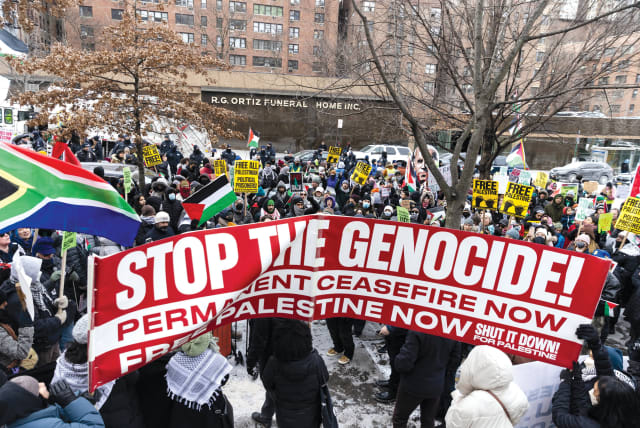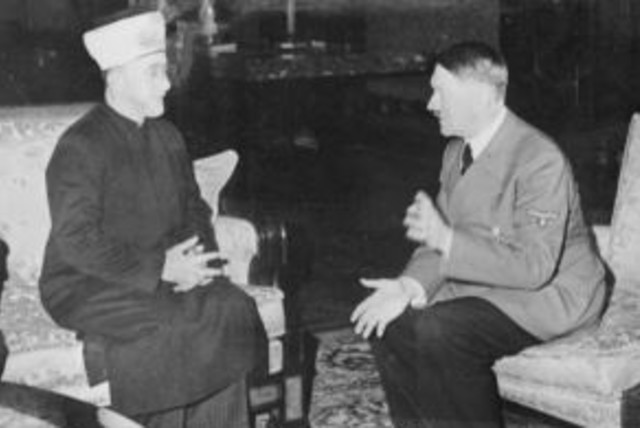The world must be reminded of the Palestinian genocide campaign against Jews - opinion

There was a genocide campaign. It was conducted not against ‘Palestine’, but in Palestine, in the Mandate of Palestine.
If you do a Google search for the entry “Palestinian genocide accusation,” it starts with the 1948 Nakba, goes on to the 1967 Naksa, includes the Maronite-perpetrated Sabra and Shatila killings, and ends with the Gaza blockade. It references such terms as “ethnic cleansing,” “politicide,” “spaciocide,” and “cultural genocide.”
However, if you are looking for this year’s model, the entry is titled “Allegations of genocide in the 2023 Israeli attack on Gaza.” That includes such sub-sections as “Alleged genocidal intent,” “Academic and legal discourse,” “Statements by political organizations and governments,” and “Cultural discourse.” When I last looked, there were 299 references, not including footnotes.
The charge that Israel is engaged in a campaign of genocide in Gaza is ubiquitous, from The Hague to campuses, to the media, and in the streets. It is heard in museums and art galleries. It has led to the slogan “Abolish Zionism.” In a medical journal, British Medical Global Health, Israel’s policies were described as an “eliminatory settler colonial strategy.”
All this is propaganda, of course. After all, despite Israel’s campaigns against Hamas aggression, Gaza’s population shows no real signs of any serious demographic downfall. Neither has that of Judea and Samaria, except for voluntary emigration abroad.

Yet, there was a genocide campaign. It was conducted not against ‘Palestine’, but in Palestine, in the Mandate of Palestine. It was a campaign of attempted genocide, not against Arabs but against the Jews. It began in April 1920, and through riots, pogroms, and terror, as well as political and diplomatic pressure, it has not let up.
Attacks against Jews during the British mandate
Following the first murderous riot in Jerusalem during the Passover festival that coincided with the Nebi Mussa celebration, mob violence occurred again and again throughout the Mandate period. These attacks, as well as those that followed, targeted almost exclusively the defenseless and the weak – women, the elderly, and the young.
Although there were instances of violence over property and land purchases, as in Jerusalem in 1851, when Rabbi Avraham Shlomo Zalman Zoref was stabbed to death after obtaining permission to reconstruct the Hurva synagogue, or in Petah Tikva in 1886, these were localized events. With the Balfour Declaration, the San Remo Conference, and the separation of Palestine, known as Southern Syria, from Syria, the violence assumed a nationalist character that categorized all Jews as justified potential victims of Arab violence.
In Jerusalem, when Jewish schoolchildren marked the occasion of the first anniversary of the Balfour Declaration in a procession on November 2, 1918, Arab ruffians, encouraged by the Arab mayor, fell upon them with clubs. Ze’ev Jabotinsky, who was in the city, reported to Chaim Weizmann that there was a pogrom atmosphere and decried the lack of essential British security personnel.
As for Weizmann, he found himself engaged in countering an anti-Zionist propaganda campaign that claimed the Zionists were planning to replace the Dome of the Rock with a Temple, the echoes of which reverberate today. He even traveled to Egypt to meet the Sultan in an attempt to defuse this religiously activated potential explosion.
On November 27, 1919, a protest against Zionism was sent to the US Consulate offices in Haifa that included a direct threat of violence: “We hereby declare that we are not responsible for any trouble or disorder that may occur in this country as a consequence of the obvious general excitement and dissatisfaction.”
Tel Hai was attacked by marauding Bedouins in December 1919 and on February 2, 1920, resulting in two fatalities. It was then overrun on March 1 and Joseph Trumpeldor and his five compatriots were killed.
Sunday, April 4, 1920, during Passover, developed into a day of bloodshed. Here is what Khalil al-Sakakini recalled watching:
“[A] riot broke out, the people began to run about, and stones were thrown at the Jews… There were screams… I saw one Hebronite approach a Jewish shoeshine boy…take his box and beat him over the head… The riot reached its zenith. All shouted, ‘Muhammad’s religion was born with the sword’ … My soul is nauseated and depressed.”
By the end of the day, seven Jews had been murdered and two Jewish women had been raped. Many dozens were injured. The pattern had been set. Any and all Jews were to be killed; any and all Jews were legitimate targets for Arabs, and the method of killing was beastly and barbaric.
Those events were repeated in May 1921 in Jaffa, November 1921 in Jerusalem, August 1929, and for the almost three continuous years of 1936-1939, when over 500 Jews were murdered. During the in-between years, Arab genocidal terror occurred, such as the operations of Sheikh Izz ad-Din al-Qassam at Yagur and Nahalal. During the 1948 War of Independence, the genocidal phrase “drive the Jews into the sea” was often repeated.
Scholars over the past three decades have researched and chronicled what historians Matthias Küntzel and Jeffrey Herf term “the collaboration of leading [Arab] Palestinian nationalists with the Nazi regime,” despite Yad Vashem’s official unwillingness to link the Mufti directly to the Holocaust.
What is undeniable is that the British, under pressure to halt Arab terror, chose to severely restrict Jewish immigration into the Mandate just when the Hitler regime was beginning to accelerate its anti-Jewish policies. Due to the Arab violence, Jews had nowhere to flee. When the war broke out, they were trapped. The Mufti assisted in the fulfillment of the Nazis’ genocidal Final Solution.
In a current, invidious inversion, Mahmoud Al-Habbash, Mahmoud Abbas’s adviser on religious and Islamic affairs, said on February 10, as reported by Palestine Media Watch: “It may be that what the Palestinian people is experiencing now… by Israel… did not happen even in World War II… [and] are worse and a more criminal holocaust against the Palestinian people.”
Yes, there was a campaign of genocide in Palestine, but it was directed at the Jews. We need to remind the world of what happened.
The writer is a researcher, analyst, and opinion commentator on political, cultural, and media issues.
